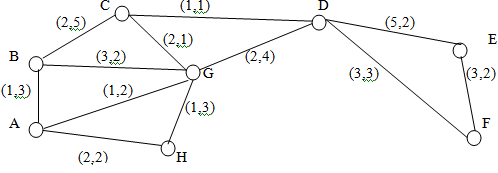Q 1. Select a route by using LD, LC, DCUR heuristic and RDM heuristic for a call R whose specifications are R =(1,A,F, B,12). Cost and delay values are specified in the brackets for the respective links. Compare the results. Assume that the call satisfies the bandwidth test

Q 2. a) An incomplete VTCSMA-L transmission status table for ? = 2 and transmission time equal to 20 is given below. Find how many calls can be sent and at what time?
|
Node
|
RC at arrival
|
DM
|
LM
|
RC at Transmission
|
|
1
|
2
|
28
|
8
|
|
|
2
|
10
|
40
|
20
|
|
|
3
|
12
|
56
|
36
|
|
|
4
|
18
|
68
|
48
|
|
|
5
|
24
|
86
|
66
|
|
|
6
|
40
|
102
|
82
|
|
Q 2. b) Show the working of LDCR and MDCR protocol on the given message set. For nodes Ni (arrival, slots, deadline) :{(4,3,30), (2,2,6), (0,1,2), (3,4,7), (5,4,16), (16,3,23)}
Q 3. a) A set of six tasks with backup copies is to be scheduled by using Myopic algorithm with some distance. Find that distance with which the tasks are feasibly scheduled. Draw schedule also.
|
Task
Ti
|
ri
|
di
|
ci
|
|
T1
|
0
|
20
|
6
|
|
T2
|
0
|
25
|
8
|
|
T3
|
4
|
30
|
5
|
|
T4
|
6
|
40
|
5
|
|
T5
|
8
|
50
|
4
|
|
T6
|
8
|
50
|
6
|
b) If the set of tasks given in Q 3 a) is scheduled on three processors using The Backup Overloading Algorithm, how much time do you save?